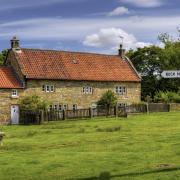Spaunton Moor is thriving and accessible to all, thanks to the conservation efforts of George Winn Darley and his team

George Winn Darley owns and manages Spaunton Moor in the North York Moors National Park, where grouse management has preserved rare habitat and wildlife for generations.
The moor is a must-visit for birdwatchers with red-listed ring ouzels among the many attractions. They arrive from Africa in April and nest along the old railway line, which runs through the estate. Senior keeper George Thompson says: ‘We count them every year and the chap who does it has found up to 16 breeding pairs in close proximity. Incredibly, he can tell which part of the moors the birds are from by their song. Bransdale ouzels have a different call to those from Rosedale.’
Winn Darley is constantly looking for ways to improve habitat and encourage wildlife. He recently undertook a project with the National Park Authority to plant stands of rowan trees so the ring ouzels can stock up on the rich berries before their migration south. As ground-nesting birds, they are vulnerable to predation, so the predator control carried out by keepers Anthony Orr and Tom Wilkinson is key to their survival. So too is the management of the heather and other moorland plants. Since Winn Darley took on the estate in 1986, 2,500 acres of bracken have been cleared and swathes of old rank heather rejuvenated through a programme of managed burning.
Current heather burning technique is very different to how it was in the 1970s when it fell to one man to carry out about 50 large fires per year. These days the keepering team aims for 500 smaller burns of ½–1 acre within the permitted burning season, from October to April. There are many advantages to burning smaller areas including much more varied habitat for grouse and a host of other wildlife.

‘It’s all about the ‘edge effect,’ says Winn Darley.
‘The most desirable houses are often on the boundary between a town and country and it’s the same for wildlife. By burning small patches you create more edges providing birds with open areas containing insect life for their chicks, next to longer heather, which offers a safe haven from avian predators.’
Another rare bird to take advantage of the recovered ground is the nightjar.
‘We often find them when we are spot spraying bracken. One year we had four pairs within half a mile. They lay late in July on bare, heathery ground to coincide with the moths, which are at their peak at that time of year,’ says George Thompson.

The North York Moors are virtually all dry heath with a shallow peat layer, so are unaffected by the recent restriction on burning on deep peat. Winn Darley has been on Defra’s Best Practice Burning Group since 2002 and has extensive knowledge of heather burning. He believes controlled burning is vital because it lowers the risk of wildfire by creating firebreaks and reducing the amount of combustible material. As a member of the England and Wales Wildfire Forum, Winn- Darley works with fire brigades across the UK.
‘Defra now sees the primary reason to carry out prescribed burning in winter months is in order to manage fuel loads and create firebreaks for summer wildfires. That penny has completely dropped and fire brigades are saying to government, if you stop these keepers burning, you need to massively up our budget,’ he says.
READ MORE: Photographs that capture the true beauty of Yorkshire heather

A recent report by the National Park Authority claimed birds of prey were diminished in the North York Moors, but the team at Spaunton believe the opposite is true and have taken the positive step of keeping a daily log of raptor sightings. They hope, over time, it will show that birds of prey have, in fact, increased in range and number. Anthony Orr adds: ‘We just jot down what we’ve seen and where at the end of the day and tally it up each month. In the first year we noted the majority of British owl and raptor species.’
Birds of prey are attracted to Spaunton thanks to habitat management and plentiful food. As well as buzzard, kestrel, peregrine falcon, barn owl and sparrowhawk, ground-nesting merlin breed every year. These small raptors are among the UK’s most endangered and the keepering team has established areas of tall heather on south-facing slopes, which are their favoured nesting sites. Merlin are among the species for which the moor is designated a SSSI and are a particular passion of George Thompson: ‘We are really proud of our merlins, which I’m now licensed to monitor,’ he says.
This kind of adaptive conservation is also carried out on the moorland fringe for butterfly conservation. Spaunton holds the only population of threatened pearl-bordered fritillaries in the whole of the east of the UK and, working with Butterfly Conservation’s Dave Wainwright, the team has been growing the colony on Appleton Common and expanding its range.

This has been done partly by encouraging dog violets whose leaves form the diet of the caterpillar and annual counts are done by amateur naturalist and world expert on bracken Dr Roderick Robinson, showing a healthy increase in recent years.
To allow members of the public to enjoy the butterflies, permissive paths through the common have been created. On the moor, tracks and parking spaces for walkers and cyclists have been installed.
‘Most people tend to follow what we term ‘desire lines’ between destinations such as pubs, heritage sites or car parks. If you can work out where these might be you can keep wildlife disturbance to a minimum and perform a service by providing a pathway,’ says Winn Darley.
A new pathway for wheelchair users has been provided and tracks are being widened for mobility scooters.
Long-term he believes government and wildlife groups would do better to work with land managers to raise standards and together achieve the kind of success stories that abound on Spaunton Moor.
READ MORE: 5 great heather walks in Yorkshire



























